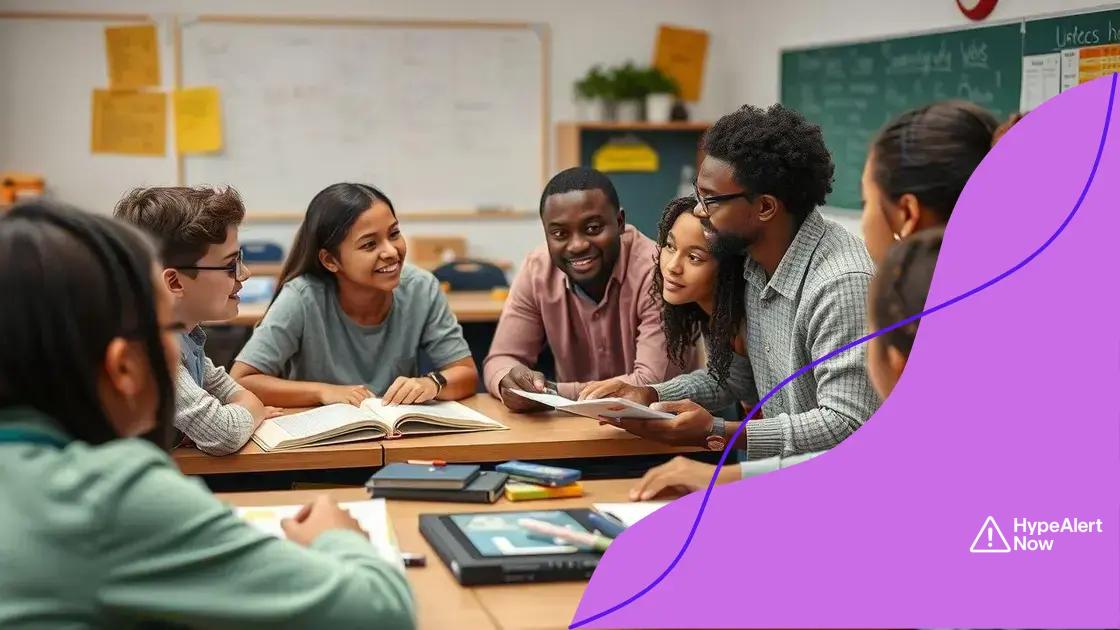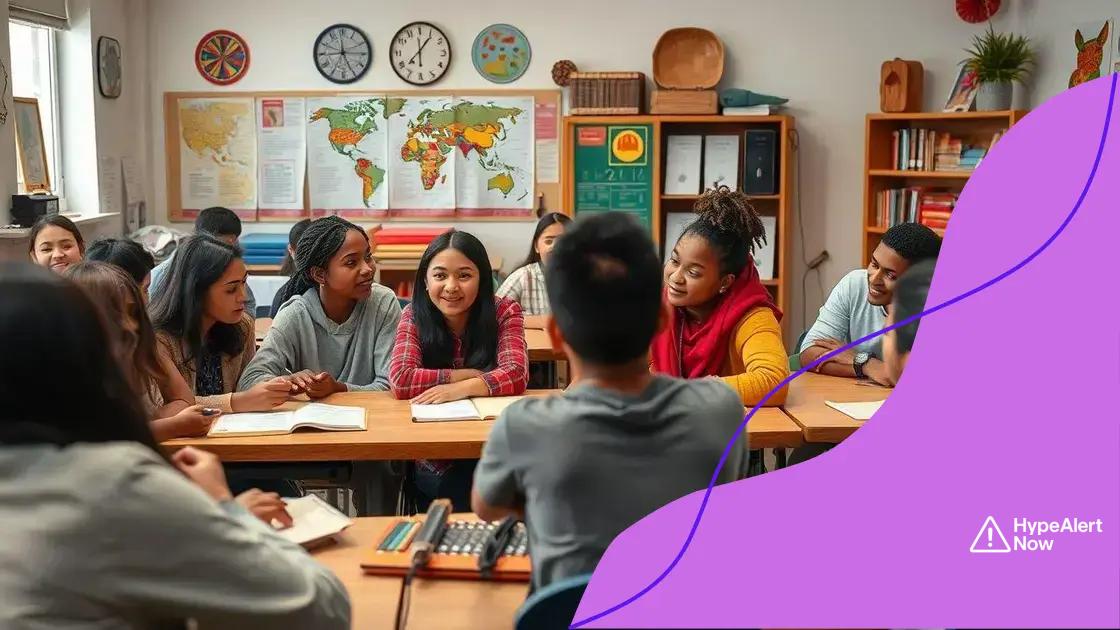Debate over curriculum content in US schools raises questions

The debate over curriculum content in US schools involves key influences such as technology integration, social-emotional learning, personalized approaches, and the importance of social responsibility in preparing students for the future.
The debate over curriculum content in US schools is more relevant than ever. It raises important questions about what students learn and how it impacts society. Have you thought about what should truly be included in education?
Understanding the current curriculum landscape
Understanding the current curriculum landscape is essential for grasping how education evolves. Many factors shape what students learn today, from state standards to community values. This dynamic environment influences not only what subjects are taught but also how they are presented in the classroom.
Key Components of Curriculum
Curricula typically contain various components that help define educational goals.
- Content standards: These outline what students need to learn at each grade level.
- Assessment strategies: These determine how student learning is measured.
- Instructional materials: This includes textbooks and digital resources that support teaching.
- Pedagogical approaches: The methods teachers use to engage students.
Each of these components plays a role in guiding what students experience in their learning journey.
Influence of State Education Boards
State education boards significantly impact schools and the curriculum they implement. They establish the standards that schools must meet, and these standards vary from state to state. This means that students in different areas may experience different curricula, which can lead to disparities in education quality.
Moreover, curriculum decisions are also guided by federal legislation, such as the Every Student Succeeds Act (ESSA), which promotes accountability and support for underperforming schools. This federal oversight aims to ensure that all students receive a fair, equitable, and high-quality education.
The debate often arises over whether the curriculum should reflect local community values or adhere strictly to educational standards set by authorities. Striking a balance between these two perspectives can create tension but also fosters valuable discussions on what is essential in education.
Trends in Curriculum Development
In recent years, several trends have emerged in curriculum development. There is a shift towards more inclusive and diverse curricula that reflect diverse cultures and perspectives. This allows students to see themselves represented in their learning.
Additionally, technology integration is changing how subjects are taught. With digital resources and online learning platforms, students can learn at their own pace, access vast information, and engage with interactive materials. This shift enhances learning experiences, making them more engaging and relevant to today’s world.
Key players in the curriculum debate
In the discussion surrounding the curriculum, several key players significantly influence decisions. These stakeholders range from educational professionals to parents and policymakers, each contributing unique perspectives to the debate.
Teachers’ Role in Curriculum Development
Teachers are on the front lines of education, making their insights vital in shaping the curriculum. They understand students’ needs and can provide feedback on what works and what doesn’t in the classroom. A teacher’s experience can influence how subjects are taught and the materials selected for lessons.
- Classroom experience: Teachers see firsthand what engages students.
- Feedback channels: Many schools encourage teachers to share their thoughts on curriculum effectiveness.
- Professional development: Opportunities for training help teachers stay current with educational trends.
Their voices are crucial in advocating for changes that reflect the needs of their students.
Parents and Community Engagement
Parents often play a significant role in curriculum debates. Their concerns about what their children learn can lead to important discussions about appropriate subject matter. Parents can voice their opinions through school boards and PTA meetings, where decisions about the curriculum are frequently discussed.
Community engagement is equally important. Local organizations and activists can push for changes that reflect community values and needs. This engagement can create a collaborative atmosphere where families feel empowered to advocate for their children’s education.
Understanding the influence of parents and community members demonstrates the shared responsibility of educating students. By working together, they can help shape a curriculum that meets diverse needs and perspectives.
Policymakers and Educational Leaders
Policymakers, including school administrators and government officials, have a broad impact on the curriculum at the district and state levels. They establish policies that guide curriculum standards and resource allocation. Their decisions influence what is taught in classrooms across entire districts.
Education leaders, like superintendents and school board members, must balance the needs of the community with state mandates. They often face pressure from various stakeholders, making their role in curriculum development complex but vital.
In this ongoing debate, it is important to recognize the contributions of all key players. Each has a role in shaping the educational landscape, and their ongoing collaboration is essential for creating a curriculum that benefits every student.
Cultural influences shaping curriculum content

Cultural influences play a significant role in shaping curriculum content in schools. Understanding these influences is essential as they affect how subjects are taught and what is included in educational materials. The backgrounds of students and the values of communities often dictate the emphasis placed on certain topics.
Diversity in the Classroom
Schools are becoming increasingly diverse, reflecting the variety of cultures present in society. This diversity prompts educators to consider a broader range of perspectives in the curriculum.
- Representation: It is essential for students to see their cultures reflected in what they study.
- Inclusive content: Materials that cater to various backgrounds help all students feel valued.
- Respect for traditions: Understanding cultural practices fosters respect and community.
Integrating this diversity into lessons encourages a more enriching educational experience for everyone.
Societal Values and Curriculum Choices
Societal values significantly influence what is prioritized in education. Issues such as social justice, environmental awareness, and equality are often reflected in curriculum content.
For instance, as society becomes more aware of climate change, many schools have begun to incorporate environmental studies into their programs. This change not only educates students about pressing global issues but also encourages them to become responsible citizens.
Incorporating values into the curriculum can spark important conversations among students, helping them understand different viewpoints and fostering critical thinking skills.
Global Influences on Education
The interconnectedness of today’s world means that cultural influences can come from across the globe. As educational resources and ideas flow from one country to another, curricula may adapt, reflecting global trends and issues.
For example, the increasing focus on technology in education can lead to the inclusion of new subjects such as coding and digital literacy. These changes help prepare students for a future where digital skills are essential for success.
By recognizing and addressing cultural influences, educators can create curricula that are not only relevant but also resonate with students’ lives, equipping them with the knowledge they need to thrive in a diverse world.
Balancing education and social responsibility
Balancing education and social responsibility is a pivotal issue in today’s schools. As educators strive to provide quality learning experiences, they also have a duty to ensure that students become responsible citizens. This balance requires careful consideration of what is taught and how it impacts society.
Understanding Social Responsibility in Education
Social responsibility means recognizing our impact on the community and the world. In education, this translates to teaching students about their roles in fostering a better society. By integrating social responsibility into the curriculum, schools can provide essential lessons about empathy, ethics, and civic duty.
- Community service: Encouraging students to participate in service projects helps develop a sense of community.
- Global awareness: Teaching students about global issues fosters understanding and prepares them to be informed citizens.
- Ethics education: Discussions about right and wrong help students make informed decisions.
These elements equip students with the skills and mindset necessary to contribute positively to their communities.
The Role of Curriculum in Promoting Responsibility
Curriculum plays a crucial role in promoting social responsibility. Schools can incorporate lessons that focus on current events, social justice, and environmental issues. This education encourages students to reflect on their opinions and consider the broader implications of their actions.
By fostering critical thinking, educators can guide students to analyze different perspectives. This approach allows them to appreciate diversity and engage with various viewpoints. Encouraging debates and discussions around social issues can also empower students to voice their opinions and advocate for causes they believe in.
Creating a Supportive Learning Environment
To balance education and social responsibility effectively, schools must create a supportive learning environment. This involves encouraging open dialogue and providing safe spaces for students to express their thoughts. Teachers can model social responsibility through their actions and interactions with students.
Mentorship programs and collaborations with local organizations can enhance this experience. Schools should partner with community leaders to create programs that address local issues, thus bridging the gap between education and social action. By engaging students in genuine problem-solving, schools can reinforce the importance of being active participants in their communities.
Ultimately, finding the right balance between education and social responsibility prepares students not only for academic success but also for becoming compassionate and engaged members of society.
Future trends in curriculum development
Future trends in curriculum development are shaping the way students learn in schools. As we look ahead, several key trends are emerging that will impact the educational landscape. Schools must adapt to these changes to prepare students for a rapidly evolving world.
Integration of Technology
Technology is playing a crucial role in transforming curriculum development. The use of digital tools and online resources enhances learning experiences and makes education more interactive.
- Blended Learning: Combining traditional classroom methods with online learning allows for more personalized education.
- Digital Literacy: Teaching students how to navigate online resources prepares them for future challenges.
- Gamification: Using game elements in learning can increase motivation and engagement.
These advancements ensure that students are not only consumers of information but also active participants in their learning.
Focus on Social-Emotional Learning (SEL)
Another trend gaining prominence is the emphasis on social-emotional learning. Schools are recognizing the importance of teaching students how to manage emotions, set goals, and develop empathy towards others.
Integrating SEL into the curriculum helps students build essential life skills. Schools may implement programs that encourage teamwork, communication, and conflict resolution. This holistic approach nurtures well-rounded individuals who can thrive both academically and socially.
Personalized Learning Approaches
The shift towards personalized learning is also becoming a key trend. Educators are increasingly recognizing that each student learns differently. Tailoring education to meet individual needs can enhance student success.
Teachers are using data-driven insights to identify students’ strengths and weaknesses. This enables them to create targeted lesson plans that address diverse learning styles. As a result, students are more engaged and motivated to learn.
In the future, curriculum development will likely focus on flexibility, allowing for adaptations based on student needs and interests. By embracing these changes, educators can create a more inclusive and effective learning environment.
FAQ – Questions about Curriculum Development Trends
What role does technology play in future curriculum development?
Technology enhances learning by providing digital tools that make education interactive and personalized.
Why is social-emotional learning important in schools?
Social-emotional learning helps students manage emotions, foster empathy, and develop essential life skills.
How can curriculum be personalized for students?
Personalized learning tailors education to individual needs, allowing teachers to create targeted lesson plans based on students’ strengths and weaknesses.
What is the significance of social responsibility in education?
Emphasizing social responsibility encourages students to engage with their communities and understand their role as active citizens.
